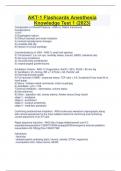AKT-1 Flashcards Anesthesia
Knowledge Test 1 (2023)
Complication of Cricoid Pressure - ANS-i.e. Sellick manoeuvre
Complications:
1) N/V
2) Esophageal rupture
3) Difficult tracheal and mask intubation
4) minimal hemodynamic changes
5) complete AW obs
6) fracture of cricoid cartillage
Contraindications of LMA - ANS-1) small oral opening
2) "full stomach" (i.e. not npo, morbidly obese, trauma, GERD, intestinal obs)
3) dec lung compliance
4) not profoundly anesthetized
5) oropharyngeal growth/trauma
Extubation Criteria - ANS-1) Oxygenation: SaO2 > 92%, PaO2 > 60 mm Hg
2) Ventillation: Vt> 5ml/kg, RR >7, ETCo2 < 50, PaCO2 <60
3) Hemodynamically stable
4) Full reversal of NMB - sustained tetany, TOF ratio > 0.9. Sustained 5-sec head lift or
hand grasp
5) Neuro - follows verbal commands, intact cough/gag
6) Acid/Base - pH > 7.25
7) Normal metabolic - electrolytes, volume status
8) Normothermic
9) Other - aspiration risk, airway edema, Awake versus Deep (recall
stage 1 - analgesia
stage 2 - excitement
stage 3 - surgical anesthesia
stage 4 - medullary paralysis)
Confirming endotracheal intubation - ANS-continuous waveform capnography along
with clinical assessment is the most reliable method of confirming and monitoring
correct placement of an ET tube
Rapid sequence induction - ANS-http://image.slidesharecdn.com/13-
enpediatricresuscitation-120507075455-phpapp02/95/emergency-lectures-pediatric-
resuscitation-49-728.jpg?cb=1336377382
Indications:
- ileus/obs
- delayed gastric emptying (pain, trauma, opioids, ETOH, vagotomy)
- incompetent LES, hiatus hernia, GERD
,- altered LOC
- neurological/NM dz
- pregnancy
- difficult AW
Contraindications:
- total AW obs
- loss of facial/oropharyngeal landmarks
- anticipated difficult intubation (lemon, 332)
Head position for tracheal intubation - ANS-head should be 10 cm above table with
extension of the atlanto-occipital joint to be in the sniffing position
Difficult Airway Mangement - ANS-
http://www.ebmedicine.net/media_library/aboutUs/Clinical%20Pathway%20Managemen
t%20Of%20The%20Difficult%20Airway.JPG
Position of Endotracheal tube - ANS-tip should be approximately 5 cm above the carina
CPR, Interruption of cardiac compressions - ANS-Primarily - Pauses for establishing
ETT (ventillation)
Secondary - rhythm checks, shocks
Therapeutic hypothermia and cardiac arrest - ANS-only useful for VT/VF
Cardiac arrest, blood gas changes - ANS-Metabolic Acidemia - Lactic Acidosis
Respiratory Acidemia/Alkalosis - depending on ventilation
Low HCO3-
Low PaO2
Neg BE (quantify degree of MA)
Hyperkalemia (from acidosis)
Hyperglcemia (stress response)
Postobstructive pulmonary edema - ANS-Obstruction then patient takes a large breath
(e.g. closed APL, patient bitting on the ETT)
Postoperative urinary retention - ANS-The risk of retention is especially high after
anorectal surgery, hernia repair, and orthopedic surgery and increases with advancing
age.
- >750 mL fluids
- Long duration of surgery
- Spinal anes with (long acting LA, high dose LA, high dose Opioids, hydrophilic opioids
like morphine)
, Risk factors for PONV - ANS-Patient:
- Female
- non smoker
- h/o motion sickness
Anesthesia:
- inhaled anesthestic
-N2O
- intra and postop opioids
Surgery:
-duration > 30 min increases risk to 60%
- types (celioscopy, ENT, Neuro, breast, strabismus, laparotomy/laproscopic, plastic
surgery)
TOF and pharyngeal muscle strength - ANS-TOF >0.9 return of pharyngeal muscle
strength. Abductor pollicis (AP) last to return
orbicularis oculi (OO) is a beter predictor of the onset of NMB at the vocal cords than
AP.
Laryngeal adductor muscles and OO block have similar onset times.
The onset time at the OO is shorter than the AP. The OO is thought to better reflect the
diaghram and laryngeal muscles than AP.
Nausea during spinal blocks - ANS-Increased vagal activity after sympathetic block
causes increased peristalsis of the gastrointestinal tract, which leads to nausea.
More common in high blocks
Contraindications to spinal anesthesia - ANS-Absolute:
- patient refusal
- local anesthetic allergy
- insurmountable technical difficulties
- active infx at site of cannulation
Relative:
- bleeding diathesis (e.g. INR >1.2 or platelets < 80)
- thrombophillia
- continuing anticoag
- hypovolemia
- severe AS/MS
- neurologic condition
- raised ICP
- previous back surgery at point of cannulation




